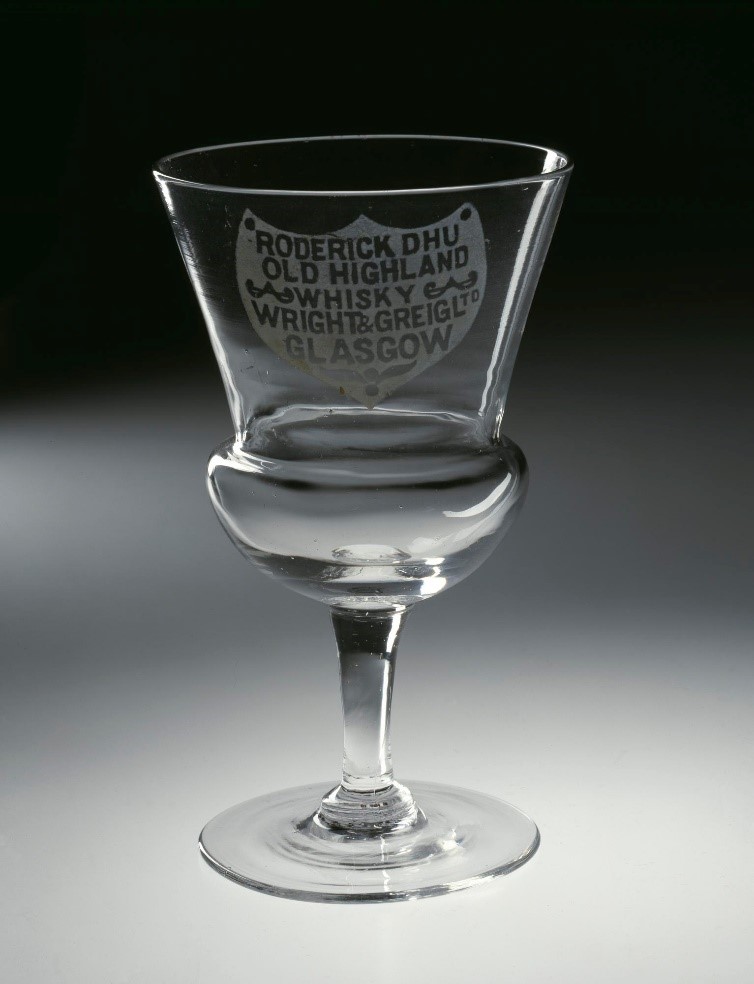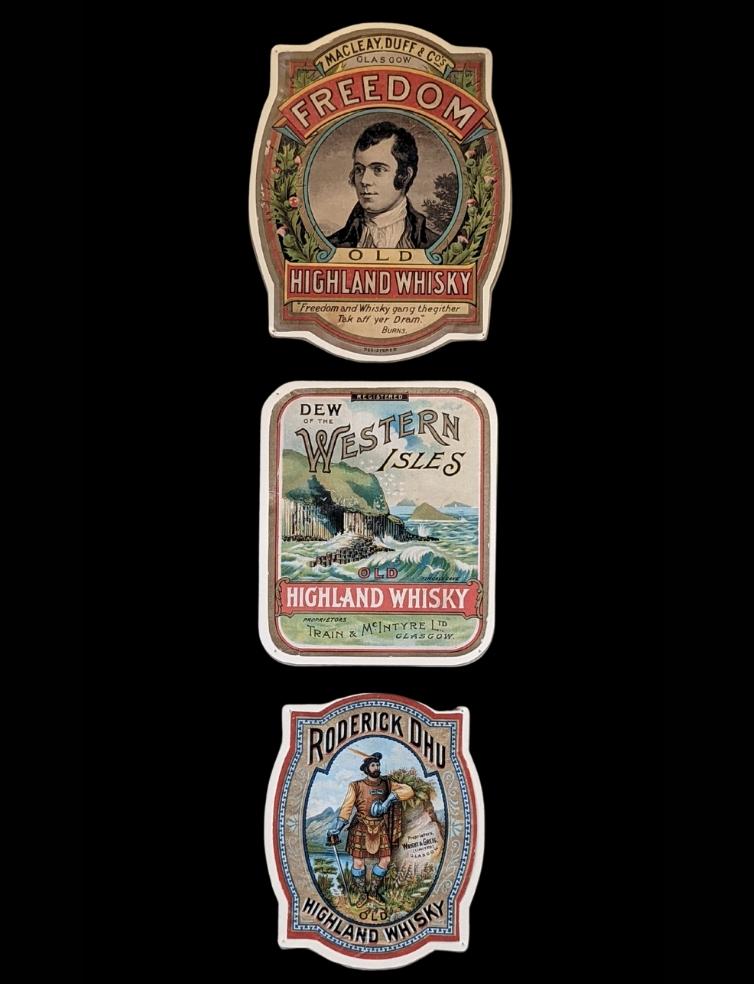Plenty of people collect whisky, but how many can say that they collect whisky for a museum? PhD student Laura Scobie has the enviable job of expanding our whisky collections. In this blog post, Laura explores the ways that whisky brands adopt a sense of place and explains how collecting contemporary examples helps us understand continuities and changes in the industry.
This blog is published in English and Ghàidhlig. Scroll down to read the Ghàidhlig version.
Tha am blog seo air fhoillseachadh ann am Beurla agus an uair sin sa Ghàidhlig. Gluais sìos an duilleag gus an tionndadh Gàidhlig a leughadh.
Whisky is an icon of Scottish identity and is ingrained in Scotland’s history and culture. It is therefore important to add to current collections with contemporary material during a flourishing of new distilleries in the twenty-first century. I study the material culture of contemporary Scottish whisky in my collaborative PhD between the National Museum of Scotland and the University of Edinburgh. Through a six-month project attached to my studies, I have been diving into the museum’s existing collections to inform contemporary collecting of Scottish whisky.
Old can be compared with the new to see how whisky’s material culture has evolved. When exploring the museum’s collections I found a broad range of material from the whisky industry, including archaeological objects related to illicit whisky distilling, tools and other objects of production, and marketing materials.
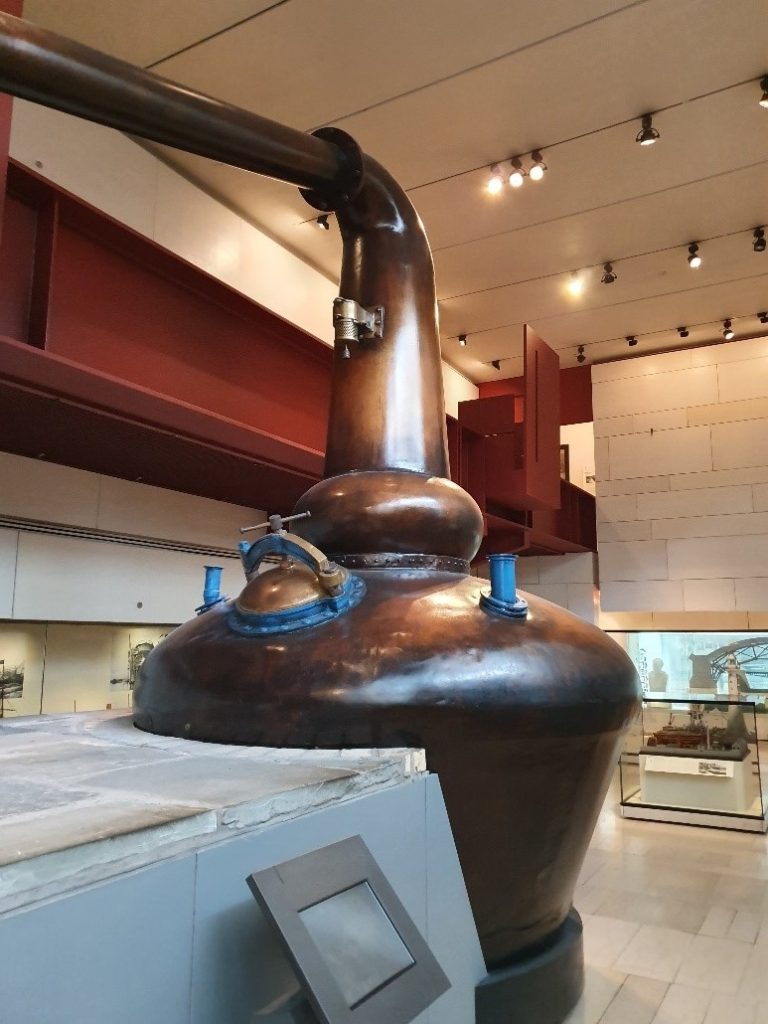
A large copper still from Glenfiddich Distillery is an eye-catching object in our Scotland Galleries. Placed in the wider context of industry and empire, the still is a recognisable image from the whisky industry and one that has endured over time. The copper and the iconic shape is revered for its effects on the character of the whisky being distilled.
With advancements made in improving glue used for adhesive labels, the first whisky labels started to appear on bottles around the end of the 1870s. A whisky label for The Usquebaugh, produced by Ross & Cameron in Inverness, is an example of elements of whisky’s history shaping whisky objects. The whisky’s quality is likened to smugglers’ whisky, appealing to the romance that has grown up around the figure of the Highland smuggler and illegal spirit. Its ‘Medicinal purposes’ taps into whisky’s use as a remedy for common colds and other ailments. Today, we still reach for a hot toddy in times of need!
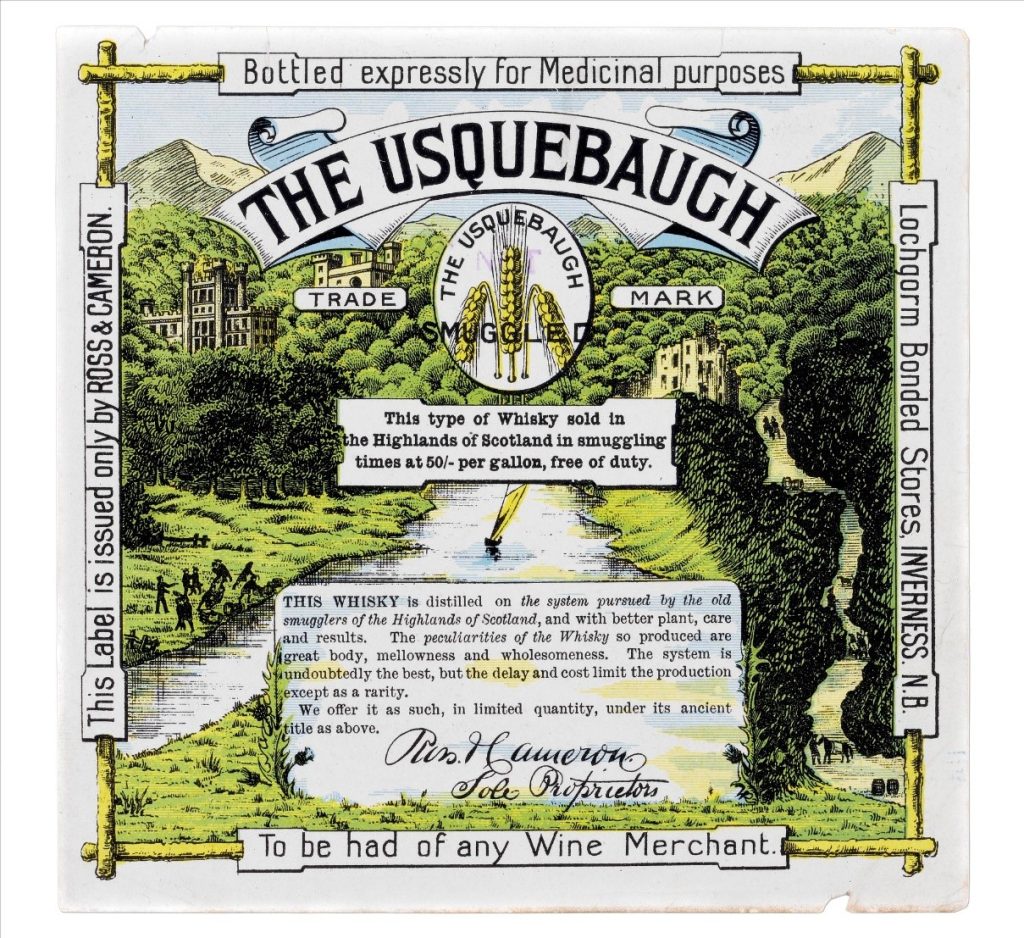
A wine glass branded with ‘Roderick Dhu Old Highland Whisky’ is one example of the variety of objects that were used to market whisky brands. The thistle bowl shape taps into popular imagery associated with Scotland’s landscape and identity. Thistles often appear on whisky labels alongside majestic stags, picture-perfect landscapes, and kilted Highland men. These romantic images of Scotland were used in whisky marketing throughout the Victorian period. Such iconography became common when modern alcohol branding arose at the turn of the twentieth century, as brands looked to expand their markets across the world.
Scotland as viewed through a tartan lens has not completely disappeared from whisky marketing, but how are distilleries (old and new) exploring a greater diversity of elements of Scotland’s past and landscape in their products? How do Scotland’s landscapes and places shape how whisky objects look today? Answering these questions is one reason why contemporary collecting of Scotland’s whisky industry is important for expanding existing collections, as well as representing the ‘now’.

I had the pleasure of visiting Raasay and Skye to explore two distilleries that have opened in the last decade. Isle of Raasay Distillery released their first single malt whisky in 2020. The glass bottle is textured with fossils and rough stone from moulds taken from Raasay’s landscape. These details of the island’s geology create a sense of place to be associated with Raasay and Isle of Raasay Distillery. They represent Raasay’s distant past, but also its present landscape in that these fossilised elements can still be found there.
The purple and yellow-brown colours used for the text on the bottle’s label are inspired by the colour of Raasay’s moors in winter. Bringing each detail together, we can see the links between symbols of landscape and building a sense of place. Finding objects that represent distillery production in a local context with focused elements of the local landscape is a fascinating part of this collecting project.
A group of objects from Torabhaig Distillery in Skye links distillery to local community, explores the use of Gaelic in contemporary Scottish culture and industry, and looks at craftwork stimulated by the whisky industry. Together, they tell a story about this distillery’s impact on ideas of place in Skye.
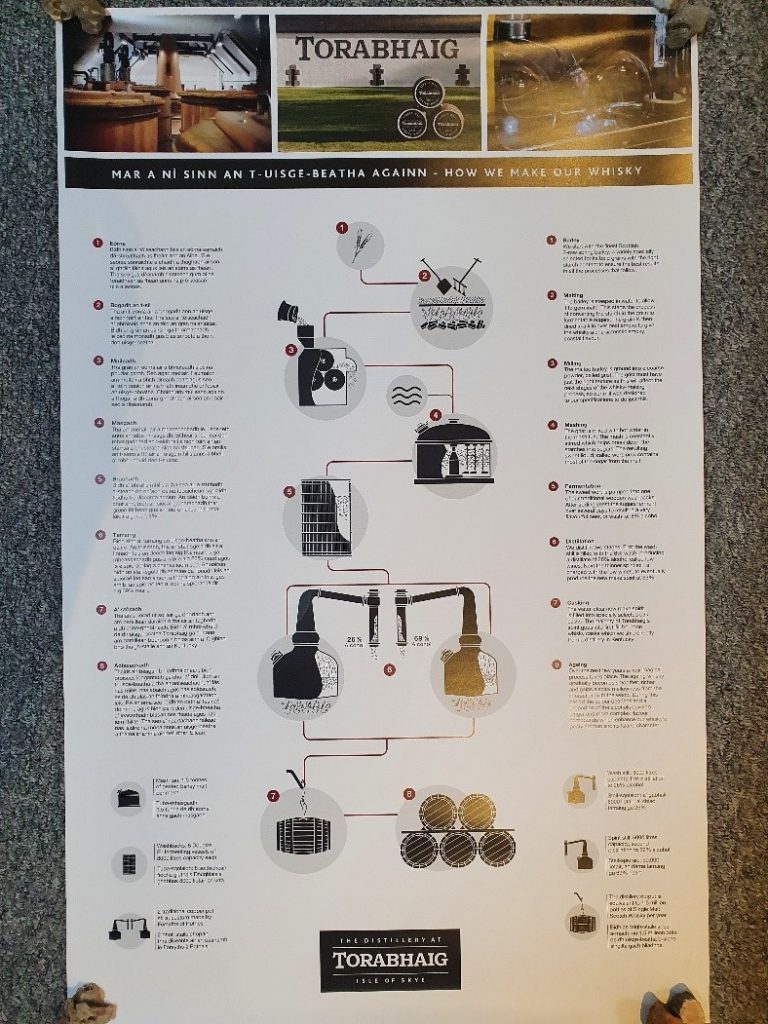
A poster titled, ‘Mar a nì sinn an t-uisge-bheatha againn’ (How we make our whisky), gives step-by-step details of the whisky-making process in Gaelic, with English translation. Objects like this are a representation of how the Gaelic language is being promoted in distinct sectors and contexts across Scotland. The poster is a localised example of a distillery contributing to the promotion of the language with close connections to their community, as Skye has one of the densest concentrations of Gaelic speakers in Scotland
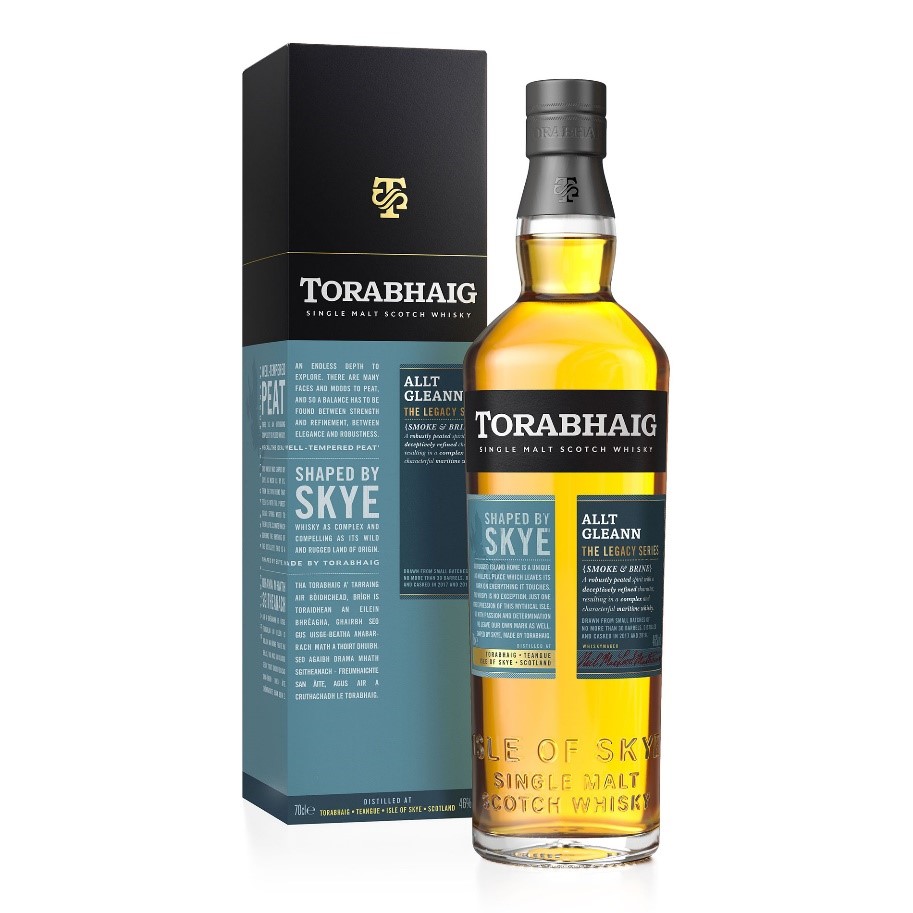
Torabhaig’s ‘Allt Gleann’ Single Malt is named after one of the burns that provide the distillery with spring water, and pairs with the slogan, ‘Shaped By Skye’. These details build a narrative of connection to Skye’s culture and landscape. A distillery’s natural water source is fundamental in shaping the character of the whisky. This connection to the landscape and a place’s water is an aspect of the whisky making process that is often used in whisky branding and marketing.
A whisky measure, made by local potter Katharina Lenz, caught my eye in the distillery shop. Made exclusively for Torabhaig, these ceramic measures reinforce the connection between the community and the distillery. I see many distilleries stimulating and supporting local craft work, and it is important to collect examples to show the growing diversity of whisky’s material culture.

Both Isle of Raasay and Torabhaig are placed on the Hebridean Whisky Trail, alongside Talisker, Isle of Harris, and Jura. This fresh trail on Scotland’s whisky map puts the Hebrides on the map as a go-to for whisky-loving tourists.
My project works with the museum’s contemporary collecting programme at an important moment, as the whisky industry flourishes against a backdrop of sustainability and environmental consciousness in Scotland and worldwide. As many new distilleries are appearing on the scene, collecting the ways they depict the relationship between whisky and place helps to show how one of Scotland’s longstanding and leading industries presents itself.
Laura Scobie is carrying out a Collaborative Doctoral Partnership funded by Arts and Humanities Research Council. This is a collaborative project with National Museums Scotland and University of Edinburgh. Laura has recently completed a six-month placement at the museum and has returned to her PhD studies.
A’ cruinneachadh uisge-bheatha Albannach an latha an-diugh
Bidh gu leòr dhaoine a’ cruinneachadh uisge-bheatha, ach cia mheud as urrainn a ràdh gu bheil iad a’ cruinneachadh uisge-bheatha airson taigh-tasgaidh? Nach ann aig an oileanach PhD Laura Scobie a tha an obair mhath is i a’ cur ri ar cruinneachaidhean uisge-bheatha. Anns a’ phost bloga seo, tha Laura a’ rannsachadh nan dòighean anns a bheil branndan uisge-bheatha a’ riochdachadh faireachdainn mu àite agus a’ mìneachadh mar a bhios cruinneachadh uisge-bheatha an latha an-diugh gar cuideachadh a’ tuigsinn leantalachd agus atharrachaidhean sa ghnìomhachas.
’S e suaicheantas de dhearbh-aithne Albannach a th’ ann an uisge-bheatha agus tha e freumhaichte ann an eachdraidh agus cultar na h-Alba. Mar sin tha e cudromach a bhith cur ri cruinneachaidhean le stuthan bhon 21mh linn nuair a tha mòran thaighean-staile ùra a’ nochdadh. Bidh mise a’ rannsachadh cultar uisge-bheatha Albannach an latha an-diugh anns a’ PhD agam a tha mi a’ dèanamh eadar Taigh-tasgaidh Nàiseanta na h-Alba agus Oilthigh Dhùn Èideann. Tro phròiseact sia mìosan an cois mo chuid ionnsachaidh, tha mi air a bhith a’ toirt sùil gheur air cruinneachaidhean an taigh-tasgaidh gus taic-fiosrachaidh a thoirt do chruinneachadh uisge-bheatha Albannach an latha an-diugh.
Faodar coimeas a dhèanamh eadar seann agus ùr gus faicinn mar a tha cultar stuthach uisge-bheatha air tighinn air adhart. Nuair a bha mi a’ rannsachadh cruinneachaidhean an taigh-tasgaidh lorg mi raon farsaing de stuthan bho ghnìomhachas an uisge-bheatha, a’ gabhail a-steach stuthan àrc-eòlach co-cheangailte ri staileadh, innealan agus stuthan-dèanaimh uisge-bheatha mì-laghail, agus stuthan margaidheachd.

Tha an stail mhòr chopair à Taigh-staile Ghlinn Fhiodhaich na nì gu math suaicheanta anns na Gailearaidhean againn an Alba. Air a cur ann an co-theacs nas fharsainge de ghnìomhachas agus ìmpireachd, tha i fhathast na h-ìomhaigh aithnichte bho ghnìomhachas an uisge-bheatha agus ìomhaigh a tha air mairsinn ùine mhòr. Tha an copar agus an cumadh suaicheanta gam meas prìseil airson na buaidh a th’ aca air caractar an uisge-bheatha.

Le leasachadh ga dhèanamh air a’ ghlaodh a chleachdadh airson leubailean steigeach, thòisich a’ chiad leubailean uisge-bheatha a’ nochdadh air botail timcheall air deireadh nan 1870an. Tha leubail uisge-bheatha airson The Usquebaugh, air a dhèanamh le Ross & Cameron ann an Inbhir Nis, na eisimpleir de dh’eachdraidh uisge-bheatha a’ toirt buaidh air nithean co-cheangailte ri uisge-bheatha. Tha an t-uisge-bheatha ga shamhlachadh ri uisge-bheatha nan cùiltearan, ga cheangal ri ìomhaigh romansach cùiltearan na Gàidhealtachd agus deoch-làidir mì-laghail. Tha luaidh air ‘cungaidh-leighis’ a’ ceangal ri mar a chleachdadh uisge-bheatha na leigheas airson a’ chnatain agus tinneasan eile. An-diugh, nach bi sinn fhathast a’ gabhail todaidh nuair nach eil sinn gu math!
Tha glainne air a bheil ‘Roderick Dhu Old Highland Whisky’ na h-eisimpleir den iomadh rud a chleachdadh airson branndan uisge-bheatha a mhargaidheachd. Tha an cluaran a’ tarraing air ìomhaighean fèillmhor co-cheangailte ri cruth-tìre agus dearbh-aithne na h-Alba. Bidh cluaran tric a’ nochdadh air leubailean uisge-bheatha còmhla ri damh mòrail, cruth-tìre àlainn, agus Gàidheal ann am fèileadh. Chaidh na h-ìomhaighean romansach seo de dh’Alba a chleachdadh ann am margaidheachd uisge-bheatha fad linn Bhictòria. Dh’fhàs ìomhaigheachd mar seo cumanta nuair a nochd branndadh deoch-làidir aig toiseach an fhicheadamh linn, leis gu robh luchd-dèanaimh airson na margaidhean aca a leudachadh air feadh an t-saoghail.
Tha ìomhaigh thartan na h-Alba fhathast ri fhaicinn ann am margaidheachd uisge-bheatha, ach ciamar a tha taighean-staile (sean is ùr) a’ feuchainn ri barrachd iomadachd bho eachdraidh agus cruth-tìre na h-Alba a thoirt an lùib na tha iad a’ reic? Ciamar a tha cruthan-tìre agus àiteachan na h-Alba a’ cumadh mar a tha nithean co-cheangailte ri uisge-bheatha a’ coimhead an-diugh? Is e a bhith a’ freagairt nan ceistean sin aon adhbhar gu bheil cruinneachadh co-aimsireil de ghnìomhachas uisge-bheatha na h-Alba cudromach airson cruinneachaidhean a leudachadh, a bharrachd air a bhith a’ riochdachadh an ‘latha an-diugh’.

Bha e na thlachd dhomh tadhal air Ratharsair agus an Eilean Sgitheanach a rannsachadh dà thaigh-staile a tha air fosgladh anns an deichead mu dheireadh. Nochd a’ chiad uisge-bheatha braiche singilte aca à Taigh-staile Eilean Ratharsair ann an 2020. Tha am botal glainne air a sgeadachadh le ìomhaigh fhosailean agus clach gharbh à molltairean a chaidh a thogail bho chruth-tìre Ratharsair. Tha am fiosrachadh seo mu gheòlas an eilein a’ cruthachadh faireachdainn de dh’àite co-cheangailte ri Taigh-staile Ratharsair is Eilean Ratharsair. Tha iad a’ riochdachadh seann eachdraidh Ratharsair, ach cuideachd an cruth-tìre a th’ ann an-diugh leis gu bheil na fosailean seo rim faighinn ann fhathast.
Tha na dathan purpaidh is buidhe-donn a thathar a’ cleachdadh airson an teacsa air leubail a’ bhotail air am brosnachadh le dath monaidhean Ratharsair sa gheamhradh. Le bhith a’ toirt gach eileamaid còmhla, chì sinn na ceanglaichean eadar samhlaidhean cruth-tìre agus mothachadh air àite. Tha lorg nithean a tha a’ riochdachadh obair taigh-staile ann an co-theacs ionadail le eileamaidean cuimsichte air sealladh-tìre na sgìre na phàirt air leth inntinneach den phròiseact cruinneachaidh seo.
Tha grunn nithean à Taigh-staile Thorabhaig san Eilean Sgitheanach a’ ceangal an taigh-staile ris a’ choimhearsnachd ionadail, a’ rannsachadh cleachdadh na Gàidhlig ann an cultar is gnìomhachas na h-Alba an latha an-diugh, agus a’ coimhead air obair-chiùird a tha air a bhrosnachadh le gnìomhachas an uisge-bheatha. Còmhla, tha iad ag innse sgeulachd mun bhuaidh a th’ aig an taigh-staile seo air beachdan mu àite san Eilean Sgitheanach.

Tha postair leis an tiotal, ‘Mar a nì sinn an t-uisge-bheatha againn’, ag innse ceum air cheum sa Ghàidhlig mu phròiseas dèanaimh uisge-bheatha, le eadar-theangachadh Beurla. Tha nithean mar seo a’ riochdachadh mar a thathar a’ brosnachadh na Gàidhlig ann an roinnean agus co-theacsan sònraichte air feadh na h-Alba. Tha am postair na eisimpleir ionadail de thaigh-staile a tha a’ cur ri adhartachadh a’ chànain le ceanglaichean dlùth ris a’ choimhearsnachd aca, leis gur ann san Eilean Sgitheanach a tha aon de na sluaghan as dùmhlaichte de luchd-labhairt na Gàidhlig ann an Alba.

Tha Uisge-bheatha Braiche Singilte ‘Allt Gleann’ Thorabhaig air ainmeachadh air fear de na h-uillt a tha a’ toirt uisge don taigh-staile, agus na chois tha an sluagh-ghairm, ‘Shaped By Skye’. Tha seo a’ toirt luaidh air a’ cheangal ri cultar agus cruth-tìre an Eilein Sgitheanaich. Tha stòr uisge nàdarra taigh-staile bunaiteach ann a bhith a’ cumadh caractar an uisge-bheatha. Tha an ceangal seo ri cruth-tìre agus uisge na phàirt den phròiseas dèanaimh uisge-bheatha a thathas gu tric a’ cleachdadh ann am branndadh agus margaidheachd uisge-bheatha.
Chaidh mi shùil a tharraing le tomhas uisge-bheatha, a rinn a’ chreadhadair ionadail Katharina Lenz, ann am bùth an taigh-staile. Air an dèanamh a-mhàin airson Torabhaig, tha na tomhasan crèadha seo a’ daingneachadh a’ cheangail eadar a’ choimhearsnachd agus an taigh-staile. Tha mi a’ faicinn mòran thaighean-staile a’ brosnachadh agus a’ toirt taic do obair-ciùird ionadail, agus tha e cudromach eisimpleirean a chruinneachadh gus sìor fhàs iomadachd a’ chultair co-cheangailte ri uisge-bheatha a shealltainn.

Tha Isle of Raasay agus Torabhaig air Slighe Uisge-bheatha Innse Gall, còmhla ri Talisker, Isle of Harris, agus Jura. Tha an t-slighe ùr seo air mapa uisge-bheatha na h-Alba a’ cur Innse Gall air adhart do luchd-turais a tha dèidheil air uisge-bheatha.
Tha am pròiseact agam ag obair le prògram cruinneachaidh co-aimsireil an taigh-tasgaidh aig àm cudromach, leis gu bheil gnìomhachas an uisge-bheatha a’ soirbheachadh ann an co-theacsa de sheasmhachd agus mothachadh àrainneachd ann an Alba agus air feadh an t-saoghail. Le mòran thaighean-staile ùra a’ nochdadh, tha cruinneachadh nan dòighean anns a bheil iad a’ sealltainn a’ cheangail eadar uisge-bheatha agus àite a’ cuideachadh le bhith a’ taisbeanadh mar a tha fear de phrìomh sheann ghnìomhachasan na h-Alba ga thaisbeanadh fhèin.
Tha Laura Scobie a’ dèanamh Com-pàirteachas Dotaireil Co-obrachail air a mhaoineachadh le Comhairle Rannsachaidh nan Ealan is nan Daonnachdan. Is e pròiseact co-obrachail a tha seo eadar Taighean-tasgaidh Nàiseanta na h-Alba agus Oilthigh Dhùn Èideann. O chionn ghoirid rinn Laura sia mìosan obrach aig an taigh-tasgaidh agus tha i a-nis air tilleadh gu a ceum PhD.

